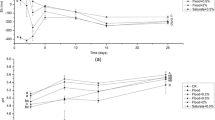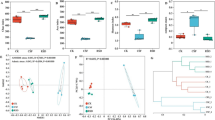Abstract
The different impacts, especially on soil physicochemical and microbial characteristics, among disinfestation methods based on different principles (including physical, chemical, and biological) have not been illustrated well. Here, we used steam sterilization, dazomet fumigation, and reductive soil disinfestation (RSD) methods representative of physical, chemical, and biological soil disinfestation, respectively, to disinfest seriously degraded greenhouse soils before watermelon cultivation in one season. Compared with the control, RSD significantly decreased the soil nitrate content by 85.9% and the electrical conductivity by 52.0% and increased the soil pH to 7.44. Although all three soil disinfestations significantly decreased the abundance of the pathogen Fusarium oxysporum by 83.0–99.2%, their impacts on soil microbial characteristics were variable. Briefly, steam sterilization significantly changed multiple bacterial and fungal properties. Dazomet fumigation impacted mainly fungal properties, such as abundance, diversity, and community structure, but RSD significantly decreased bacterial diversity and altered the bacterial community structure. Although the differences mentioned above got smaller after watermelon cultivation, the plant performances differed dramatically in different soils. The largest plant biomass, fruit ratio, and yield were found in the RSD-treated soil, whereas the lowest fruit ratio and yield were found in the steam-sterilized soil. The soil nitrate content, electrical conductivity, bacterial diversity and community structure, and some specific microbial agents, such as Aspergillus, Cladosporium, and Pseudomonas, were correlated with plant performance. RSD is a promising soil disinfestation strategy to support plant growth in intensively cultivated greenhouse soils with serious problems, such as acidification, salinization, and pathogen accumulation.






Similar content being viewed by others
References
Baker KF (1962) Principles of heat treatment of soil and planting material. J Aust Inst Agric Sci 28:118–126
Burgin AJ, Hamilton SK (2005) Have we overemphasized the role of denitrification in aquatic ecosystems: a review of nitrate removal pathways. Front Ecol Environ 5:89–96
Cao ZH, Huang JF, Zhang CS, Li AF (2004) Soil quality evolution after land use change from paddy soil to vegetable land. Environ Geochem Health 26:97–103
Caporaso JG, Kuczynski J, Stombaugh J, Bittinger K, Bushman FD, Costello EK, Fierer N, Peña AG, Goodrich JK, Gordon JI, Huttley GA, Kelley ST, Knights D, Koenig JE, Ley RE, Lozupone CA, McDonald D, Muegge BD, Pirrung M, Reeder J, Sevinsky JR, Turnbaugh PJ, Walters WA, Widmann J, Yatsunenko T, Zaneveld J, Knight R (2010) QIIME allows analysis of high-throughput community sequencing data. Nat Methods 7(5):335–336
Chaparro JM, Badri DV, Bakker MG, Sugiyama A, Manter DK, Vivanco JM (2013) Root exudation of phytochemicals in Arabidopsis follows specific patterns that are developmentally programmed and correlate with soil microbial functions. PLoS One 8(2):e525
Chen Q, Zhang X, Zhang H, Christie P, Li X, Horlacher D, Liebig H (2004) Evaluation of current fertilizer practice and soil fertility in vegetable production in the Beijing region. Nutr Cycl Agroecosyst 69:51–58
Cho J-M, Kim K-J, Chung K-Y, Hyun S, Baek K (2009) Restoration of saline soil in cultivated land using electrokinetic process. Sep Sci Technol 44(10):2371–2384
Delmont TO, Francioli D, Jacquesson S, Laoudi S, Mathieu A, Nesme J, Ceccherini MT, Nannipieri P, Simonet P, Vogel TM (2014) Microbial community development and unseen diversity recovery in inoculated sterile soil. Biol Fertil Soils 50(7):1069–1076
Di Pietro A, Madrid MP, Caracuel Z, Delgado-Jarana J, Roncero MIG (2003) Fusarium oxysporum: exploring the molecular arsenal of a vascular wilt fungus. Mol Plant Pathol 4(5):315–325
Dodds PN, Rathjen JP (2010) Plant immunity: towards an integrated view of plant-pathogen interactions. Nat Rev Genet 11:539–548
Duniway JM (2002) Status of chemical alternatives to methyl bromide for pre-plant fumigation of soil. Phytopathology 92:1337–1343
Elad Y (2010) Trichoderma harzianum T39 preparation for biocontrol of plant diseases-control of Botrytis cinerea, Sclerotinia sclerotiorum and Cladosporium fulvum. Biocontrol Sci Tech 10(4):499–507
Gamliel A, Austerweil M, Kritzman G (2000) Non-chemical approach to soilborne pest management-organic amendments. Crop Prot 19:847–853
Gordon TR (2017) Fusarium oxysporum and the Fusarium wilt syndrome. Annu Rev Phytopathol 55:23–39
Gullino ML, Camponogara A, Gasparrini G, Rizzo V, Clini C, Garibaldi A (2003) Replacing methyl bromide for soil disinfestation: the ltalian experience and implications for other countries. Plant Dis 87:1012–1021
Haichar FZ, Marol C, Berge O, Rangel-Castro JI, Prosser JI, Balesdent J, Heulin T, Achouak W (2008) Plant host habitat and root exudates shape soil bacterial community structure. ISME J 2(12):1221–1230
Huang X, Liu L, Wen T, Zhang J, Wang F, Cai Z (2016) Changes in the soil microbial community after reductive soil disinfestation and cucumber seedling cultivation. Appl Microbiol Biotechnol 100(12):5581–5593
Huang X, Liu L, Zhao J, Zhang J, Cai Z (2019a) The families Ruminococcaceae, Lachnospiraceae, and Clostridiaceae are the dominant bacterial groups during reductive soil disinfestation with incorporated plant residues. Appl Soil Ecol 135:65–72
Huang X, Zhao J, Zhou X, Han Y, Zhang J, Cai ZC (2019b) How green alternatives to chemical pesticides are environmentally friendly and more efficient. Eur J Soil Sci 70(3):518–529
Janvier C, Villeneuve F, Alabouvette C, Edel-Hermann V, Mateille T, Steinberg C (2007) Soil health through soil disease suppression: which strategy from descriptors to indicators? Soil Biol Biochem 39(1):1–23
Katan J (2000) Physical and cultural methods for the management of soil-borne pathogens. Crop Prot 19:725–731
Kreutzer WA (1963) Selective toxicity of chemicals to soil microorganisms. Annu Rev Phytopathol 1:101–126
Ling N, Zhang W, Wang D, Mao J, Huang Q, Guo S, Shen Q (2013) Root exudates from grafted-root watermelon showed a certain contribution in inhibiting Fusarium oxysporum f. sp. PLoS One 8(5):e63383
Liu L, Chen S, Zhao J, Zhou X, Wang B, Li Y, Zheng G, Zhang J, Cai Z, Huang X (2018) Watermelon planting is capable to restructure the soil microbiome that regulated by reductive soil disinfestation. Appl Soil Ecol 129:52–60
López-Mondéjar R, Antón A, Raidl S, Ros M, Pascual J (2010) Quantification of the biocontrol agent Trichoderma harzianum with real-time TaqMan PCR and its potential extrapolation to the hyphal biomass. Bioresour Technol 101:2888–2891
Lu R (2000) Soil agro-chemical analyses. Agricultural Technical Press of China, Beijing
Mazza P, Noens EE, Schirner K, Grantcharova N, Mommaas AM, Koerten HK, Muth G, Flardh K, van Wezel GP, Wohlleben W (2006) MreB of Streptomyces coelicolor is not essential for vegetative growth but is required for the integrity of aerial hyphae and spores. Mol Microbiol 60(4):838–852
Mehrabi Z, McMillan VE, Clark IM, Canning G, Hammond-Kosack KE, Preston G, Hirsch PR, Mauchline TH (2016) Pseudomonas spp. diversity is negatively associated with suppression of the wheat take-all pathogen. Sci Rep 6:29905
Meng T, Wang Q, Abbasi PA, Ma Y (2019) Deciphering the differences in the chemical and microbial characteristics between the healthy and Fusarium wilt infected watermelon rhizosphere soils. Appl Microbiol Biotechnol 103(3):1497–1509
Minuto A, Spadaro D, Garibaldi A, Gullino LM (2006) Control of soilborne pathogens of tomato using a commercial formulation of Streptomyces griseoviridis and solarization. Crop Prot 15:735–742
Momma N, Kobara Y, Uematsu S, Kita N, Shinmura A (2013) Development of biological soil disinfestations in Japan. Appl Microbiol Biotechnol 97(9):3801–3809
Mowlick S, Inoue T, Takehara T, Kaku N, Ueki K, Ueki A (2013) Changes and recovery of soil bacterial communities influenced by biological soil disinfestation as compared with chloropicrin-treatment. AMB Express 3:46–58
Oksanen J, Blanchet FG, Kindt R, Legendre P, O’Hara RB, Simpson GL, Solymos P, Stevens MHH, Wagner H (2011) Vegan: community ecology package. R package version, pp 117–118
Pal KK, McSpadden Gardener B (2006) Biological control of plant pathogens. Plant Health Instructor. https://doi.org/10.1094/PHI-A-2006-1117-1002
Pandey P, Ramegowda V, Senthil-Kumar M (2015) Shared and unique responses of plants to multiple individual stresses and stress combinations: physiological and molecular mechanisms. Front Plant Sci 6:723
Power JF, Schepers JS (1989) Nitrate contamination of groundwater in North America. Agric Ecosyst Environ 26:165–187
Rosskopf EN, Serrano-Pérez P, Hong J, Shrestha U, Rodríguez-Molina MC, Martin K, Kokalis-Burelle N, Shennan C, Muramoto J, Butler D (2015) Anaerobic soil disinfestation and soilborne pest management. In: Meghvansi MK, Varma A (eds) Organic amendments and soil suppressiveness in plant disease management. Springer International Publishing, Cham, pp 277–305
Runia WT, Molendijk LPG (2010) Physical methods for soil disinfestation in intensive agriculture: old methods and new approaches. Acta Hortic (883):249–258
She S, Niu J, Zhang C, Xiao Y, Chen W, Dai L, Liu X, Yin H (2017) Significant relationship between soil bacterial community structure and incidence of bacterial wilt disease under continuous cropping system. Arch Microbiol 199(2):267–275
Shi WM, Yao J, Yan F (2008) Vegetable cultivation under greenhouse conditions leads to rapid accumulation of nutrients, acidification and salinity of soils and groundwater contamination in south-eastern China. Nutr Cycl Agroecosyst 83(1):73–84
Tilman D, Cassman KG, Matson PA, Naylor R, Polasky S (2002) Agricultural sustainability and intensive production practices. Nature 418:671–677
van Bruggen AHC, Semenov AM (2000) In search of biological indicators for soil health and disease suppression. Appl Soil Ecol 15:13–24
van Bruggen AHC, Gamliel A, Finckh MR (2016) Plant disease management in organic farming systems. Annu Rev Phytopathol 72(1):30–44
Zhao J, Li Y, Wang B, Huang X, Yang L, Lan T, Zhang J, Cai Z (2017) Comparative soil microbial communities and activities in adjacent Sanqi ginseng monoculture and maize-Sanqi ginseng systems. Appl Soil Ecol 120:89–96
Zhu T, Zhang J, Cai Z (2011) The contribution of nitrogen transformation processes to total N2O emissions from soils used for intensive vegetable cultivation. Plant Soil 343(1–2):313–327
Funding
This work was funded by the National Natural Science Foundation of China (41701304), National Program on Key Basic Research Project of China (973 Program) (2015CB150500), National Science Foundation for Young Scientists of China (41601266), Postdoctoral Science Foundation of China (2016 M601756), and Jiangsu Planned Projects for Postdoctoral Research Funds (1701018B).
Author information
Authors and Affiliations
Corresponding authors
Ethics declarations
Conflict of interest
The authors declare that they have no conflict of interest.
Ethical approval
This article does not contain any studies with human participants or animals performed by any of the authors.
Additional information
Publisher’s note
Springer Nature remains neutral with regard to jurisdictional claims in published maps and institutional affiliations.
Electronic supplementary material
ESM 1
(PDF 841 kb)
Rights and permissions
About this article
Cite this article
Meng, T., Ren, G., Wang, G. et al. Impacts on soil microbial characteristics and their restorability with different soil disinfestation approaches in intensively cropped greenhouse soils. Appl Microbiol Biotechnol 103, 6369–6383 (2019). https://doi.org/10.1007/s00253-019-09964-z
Received:
Revised:
Accepted:
Published:
Issue Date:
DOI: https://doi.org/10.1007/s00253-019-09964-z




